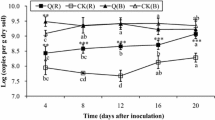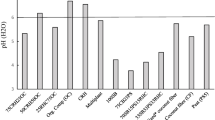Abstract
The 2,4-dichlorophenoxyacetic acid (2,4-D) degrading pseudomonad, Pseudomonas cepacia DBO1(pRO101), was inoculated at approximately 107 CFU/g into sterile and non-sterile soil amended with 0, 5 or 500 ppm 2,4-D and the survival of the strain was studied for a period of 44 days. In general, the strain survived best in sterile soil. When the sterile soil was amended with 2,4-D, the strain survived at a significantly higher level than in non-amended sterile soil. In non-sterile soil either non-amended or amended with 5 ppm 2,4-D the strain died out, whereas with 500 ppm 2,4-D the strain only declined one order of magnitude through the 44 days.
The influence of 0,0.06, 12 and 600 ppm 2,4-D on short-term (48 h) survival of P. cepacia DBO1(pRO101) inoculated to a level of 6×104, 6×106 or 1×108 CFU/g soil was studied in non-sterile soil. Both inoculum level and 2,4-D concentration were found to have a positive influence on numbers of P. cepacia DBO1(pRO101). At 600 ppm 2,4-D growth was significant irrespective of the inoculation level, and at 12 ppm growth was stimulated at the two lowest inocula levels.
P. cepacia DBO1(pRO101) was able to survive for 15 months in sterile buffers kept at room temperature. During this starvation, cells shrunk to about one third the volume of exponentially growing cells.
Similar content being viewed by others
Abbreviations
- AODC:
-
acridine orange direct count
- CFU:
-
colony forming units
- PTYG-Agar:
-
peptone, tryptone, yeast & glucose agar
- TET:
-
tetracycline
- LB:
-
Luria Bertani medium
References
Acea MJ, Moore CR & Alexander M (1988) Survival and growth of bacteria introduced into soil. Soil Biol. Biochem. 20: 509–515
Balkwill DL, Leach FR, Wilson JT, McNabb JF & White DC (1988) Equivalence of microbial biomass measures based on membrane lipid and cell wall components, adenosine triphosphate, and direct counts in subsurface aquifer sediments. Microb. Ecol. 16: 85–97
Børnsen PK (1986) Automatic determination of bacterioplankton biomass by image analysis. Appl. Environ. Microbiol. 51: 1199–1204
Briglia M, Nurmiaho-Lassila E-L, Vallini G & Salkinoja-Salonen M (1990) The survival of the pentachlorophenol-degrading Rhodococcus chlorophenolicus PCP-1 and Flavobacterium sp. in natural soil. Biodegradation 1: 273–281
Byrd JJ, Xu H-S & Colwell RR (1991) Viable but nonculturable bacteria in drinking water. Appl Environ. Microbiol. 57: 875–878
Chaudhry GR & Chapalamadugu S (1991) Biodegradation of halogenated organic compounds. Microbiol. Rev. 55: 59–79
Fawcett RG & Collis-George N (1967) A filter-paper method for determining the moisture characteristics of soil. Aust. J. Exp. Agric. Animal Husbandry 7: 162–167
Focht DD & Brunner W (1985) Kinetics of biphenyl and polychlorinated biphenyl metabolism in soil. Appl. Environ. Microbiol. 50: 1058–1063
Fredrickson JK, Bentjen SA, Bolton H, Li SW & Van Voris P (1989) Fate of Tn5 mutants of root growth-inhibiting Pseudomonas sp. in intact soil-core microcosms. Can. J. Microbiol. 35: 867–873
Golovleva LA, Pertsova RN, Boronin AM, Travkin VM & Kozlovsky SA (1988) Kelthane degradation by genetically engineered Pseudomonas aeruginosa BS827 in a soil ecosystem. Appl. Environ. Microbiol. 54: 1587–1590
Harker AR, Olsen RH & Seidler RJ (1989) Phenoxyacetic acid degradation by the 2,4-dichlorophenoxyacetic acid (TFD) pathway of plasmid pJP4: mapping and characterization of the TFD regulatory gene, tfdR. J. Bacteriol. 171: 314–320
Hobbie JE, Daley RJ & Jasper S (1977) Use of nucleopore filters for counting bacteria by fluorescence microscopy. Appl. Environ. Microbiol. 33: 1225–1228
Holben WE, CL Lynch, A Hasebe & JM Tiedje (1989) Natural antibiotic resistance of indigenous bacteria in soils world-wide: selection of antibiotics that best control indigenous bacterial populations. Abst, P-8-20, Fifth International Symposium on Microbial Ecology (ISME5), Kyoto, Japan.
Jacobsen CJ & Pedersen JC (1992) Mineralization of 2,4-dichlorophenoxyacetic acid (2,4-D) in soil inoculated with Pseudomonas cepacia DBO1(pRO101), Alcaligenes eutrophus JMP134(pJP4); effects of inoculation level and substrate concentration. Biodegradation 2: 253–263 (this issue)
Kilbane JJ, Chatterjee DK & Chakrabarty AM (1983) Detoxification of 2,4,5-Trichlorphenoxyacetic acid from contaminated soil by Pseudomonas cepacia. Appl. Environ. Microbiol. 45: 1697–1700
Maniatis T, Fritsch EF & Sambrook J (1982) Molecular cloning, a laboratory manual. Cold Spring Harbor Laboratory, Cold Spring Harbor, NY, USA
Morel JL, Bitton G, Chaudhry GR & Awong J (1989) Fate of genetically modified microorganisms in the corn rhizosphere. Curr. Microbiol. 18: 355–360
Pedersen JC (1992) Natamycin as a fungicide in agar media. Appl. Environ. Microbiol. 58: 1064–1066
Pochon J (1954) Manuel technique d'analyse microbiologique du sol. Masson et Cie, Paris
Pillai SD & Pebber IL (1990) Survival of Tn5 mutant bean rhizobia in desert soils: phenotypic expression of Tn5 under moisture stress. Soil Biol. Biochem. 22: 265–270
Ramos JL, Duque E & Ramos-Gonzales M-I (1991) Survival in soils of an herbicide-resistant Pseudomonas putida strain bearing a recombinant TOL plasmid. Appl. Environ. Microbiol. 57: 260–266
Roszak DB & RR Colwell (1987) Survival strategies of bacteria in the natural environment. Microbiol. Rev. 51: 365–379
Sambrook J, Fritsch EF & Maniatis T (1989) Molecular Cloning, a Laboratory Manual. Cold Spring Harbor Laboratory Press, Cold Spring Harbor, NY, USA
Short KA, Seidler RJ & Olsen RH (1990) Survival and degradative capacity of Pseudomonas putida induced or constitutively expressing plasmid-mediated degradation of 2,4-dichlorophenoxyacetate (TFD) in soil. Can. J. Microbiol. 36: 821–826
Schmidt EL & Paul EA (1982) Microscopic methods for soil microorganisms. In: Page AL, Miller RH & Keeney DR (Eds) Methods of Soil Analysis (pp 803–814). Madison, Wisconsin, USA
Streber WR, Timmis KN & Zenk MH (1987) Analysis, cloning and high-level expression of 2,4-dichlorophenoxyacetate monooxygenase gene tfdA of Alcaligenes eutrophus JMP134. J. Bacteriol. 169: 2950–2955
Topp E & Hanson RS (1990) Factors influencing the survival and activity of a pentachlorophenol-degrading Flavobacterium sp. in soil slurries. Can. J. Soil Sci. 70: 83–91
Wessendorf J & Lingens F (1989) Effect of culture and soil conditions on survival of Pseudomonas flourescens R1 in soil. Appl. Microbiol. Biotechnol. 31: 97–102
Author information
Authors and Affiliations
Rights and permissions
About this article
Cite this article
Jacobsen, C.S., Pedersen, J.C. Growth and survival of Pseudomonas cepacia DBO1(pRO101) in soil amended with 2,4-dichlorophenoxyacetic acid. Biodegradation 2, 245–252 (1991). https://doi.org/10.1007/BF00114556
Received:
Accepted:
Issue Date:
DOI: https://doi.org/10.1007/BF00114556




